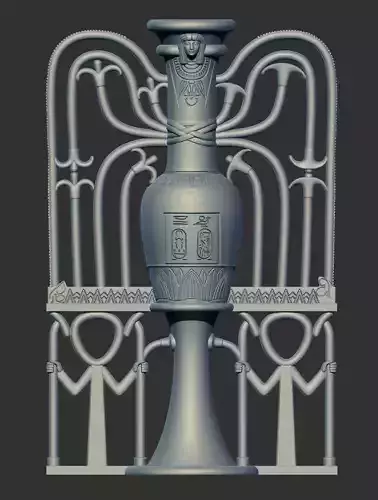1/9
Alabaster Perfume Vase of Tutankhamun 3d printable modelTutankhamun alabaster Unguent vase upon ornamental stand 3d model
An alabaster perfume vase set upon an ornamental stand features cartouches of Tutankhamun, with lotus and papyrus flowers intricately arranged to symbolize the Sema Tawy, representing the unification of Upper and Lower Egypt. The stems of these plants are depicted as signs of renpet, denoting time or eternity.
This particular vase is distinguished by the elaborate knot that binds the various plant stems around its neck. The lower section of the vase is adorned with columns topped with papyrus capitals, while the royal cartouches are elegantly inscribed on its surface.
Perfume Vase of King TutankhamunThis vase, discovered in the tomb of Tutankhamun, showcases lotus and papyrus flowers that embody the concept of Sema Tawy. The upper portion of the base suggests the natural habitat of these plants; on the left, the papyrus emerges from a marshy area, while on the right, a checkered design likely represents an irrigated plot for cultivating lotus flowers.
The vases unearthed from King Tutankhamun's tomb were primarily utilized for storing valuable oils and cosmetics intended for the king's use in the afterlife. The decorative theme on the upper section emphasizes the union of the two lands, symbolized by the lotus and the papyrus.
Sema Tawy SymbolismSema Tawy, or The Unification of the Two Lands, held great significance in ancient Egyptian mythology and political thought. It illustrated the merging of Upper Egypt (the southern region) and Lower Egypt (the northern region) into a unified kingdom.
The king, as Egypt's sovereign, was perceived as the personification of this unification, embodying the harmonious relationship between the two regions.
The Sema Tawy symbol depicted two plants: the papyrus, representing Lower Egypt, and the lotus, representing Upper Egypt, intertwined by a knotted rope. This imagery signified the connection of the two lands and the king’s responsibility in preserving unity and stability.
Beyond its political connotations, the Sema Tawy concept also carried religious and cosmic significance, representing the reconciliation of opposites and the equilibrium between various forces in the universe. The king's duty in upholding Sema Tawy was paramount.
REVIEWS & COMMENTS
accuracy, and usability.










